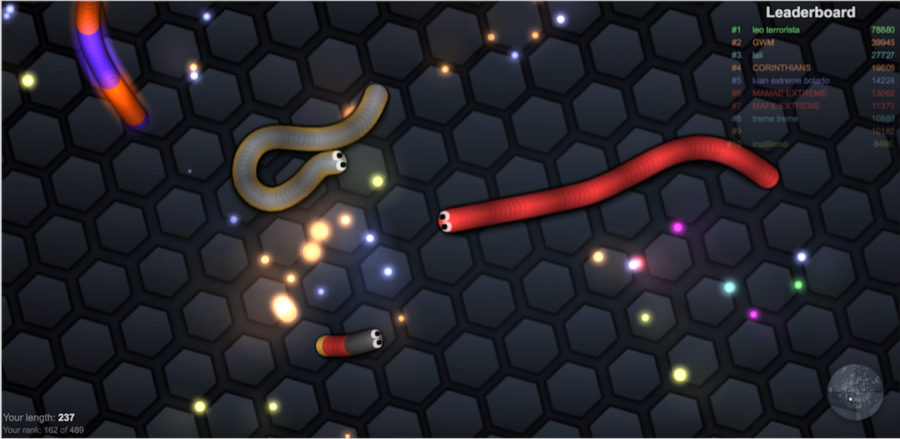Slithering into your education
I want you to imagine, just for a moment, that you are an invisible person walking down the high school hallways. Soon, third block will end and hordes of students will thud through the hallways towards the cafeteria. Now, enter the classroom with an open door coming up on your right and take a moment to examine your surroundings: the room is inhabited by 20 laptops sheltering hunched-over students. Young eyes flutter up and down, watching the teacher’s movement around the desks, before immediately being lowered – a classic sign of what now appears to be a high-school wide disease. Moving behind the students, you will notice their screens are open to the same page. The colorful shapes on the screens of many soon fade away to the startup page of the game Slither.io.
Despite the rod-like appearance of the colorful shapes on students’ screens, this is not a computer virus. Slither.io is a free, multiplayer browser game, released in March of 2016, to the eventual horror of teachers worldwide. The objective of the game is simple: control a snake in a large space and become the largest snake on the server by eating colorful balls and destroying other snakes. If the snake’s head comes into contact with any part of another snake, the player must start over. The defeated snake becomes large balls of mass consumed by other players, fueling an endless cycle of constant consumption.
Yet the question still remains, how can such a simple and seemingly boring game become successful enough to hit 68 million App Store downloads in its first 80 days? I set out to find an answer by joining the other 66,999,999 average daily players in the game after promising myself that I would try to gather as much information as possible in five minutes before exiting the tab. A few hours later, filled with moments of triumph followed by periods of vexation repeated ad infinitum, I realized that the answer I was looking for had been staring me in the face since the opening screen of the game. Slither.io is a free, distracting, technically endless and extremely easy game to pick up. There exists no better formula for the creation of a successful game.
However, the game’s success is also a sign of great danger to users, such as the ones sitting behind their computers in Graded classrooms. Those who start playing without strictly limiting themselves will soon be compulsively pressing the “play” button every time their snake dies, trying to beat their best score. Slither.io has essentially become a virus in the sense that it completely overruns the structured lives of those who play it. Symptoms of the virus may include an inability to be completely focused in class as well as an inability to escape the “just one more try” mentality. Loyal users may suffer from availability bias or gambler’s fallacy, which can cause them to overestimate the chances that they will hit the server leaderboard just because they made it to eleventh place “a few rounds ago”.
But is all hope lost? Are games, such as Slither.io, the end of computer usage in the classroom? I wouldn’t say so. With the rise in popularity of gaming in the entertainment industry, the need to revisit educators’ mindsets about the use of technology in the classroom is once again a relevant issue. As more subjects adopt the use of computers in lieu of textbooks, lab simulations and writing exercises in class, students are becoming more proficient at escaping responsibilities on increasingly larger platforms.
Though drastically reducing computer usage in the classroom may sound like the most obvious solution, it is not the best one available. What if educators were to adopt sections of the video game market, such as Slither.io, as a solution to draw students to learning, similar to what has been done with Minecraft Education Edition for younger students?
Now imagine that you are an invisible person once again walking through the Graded hallways during a regular school day. Upon entering the science classroom coming up on your right, you find engaged students learning about the forces of physics by watching a projected gameplay video of a snake eating balls of glowing mass and colliding with other players. This is a possible future only one “tab” away.
(Sources: wsj.com, scientificamerican.com)

Ever since he first “read” a book by himself (or at least phonetically memorized the contents after having it read aloud repeatedly), Alexandre has...

Lord YeJin strikes back once again in The Talon as the Photographer, the Layout Editor, and the Image Master (finally!). Evicting Gabriel Civita, the former...










